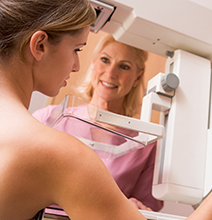Screening

Breast cancer might start as a physical change on the breast, such as a nodule or skin thickening, or an inflammatory change such as redness or hardening of the breast.
Cancer can also be suspected when, on an apparently normal breast, a mammogram reveals a mass or calcium deposits (calcifications). Although these alterations are not always signs of the disease, a doctor should look at them as soon as possible.
To be able to detect breast cancer at an early stage, when it is still asymptomatic (no symptoms) and very small (the size of a pea), has huge advantages. Not only its surgically removal is much simpler, but the chance of full recovery is about 100%.
When the tumor becomes palpable (around 2 cms) it is normally more difficult to treat. By this time it might have spread within the breast, which means bigger surgery, loss of mammary tissue, and more aggressive treatments, such as chemotherapy.
Chemotherapy (also known as chemo) Is a treatment that takes advantage from the unique characteristic of cancer cells of multiplying without control, by using drugs that specifically kill dividing cells. Although these drugs can also affect normal cells, in reality they hardly have an effect, because once our body is full grown, most of our cells do not multiply much.
How to detect the disease early?
Look for international guidelines:
- Watching for breast changes from the age of 20,
- Clinic breast exam, beginning at the age of 25,
- Mammograms every 2 years, between the age of 45 and 69 years old
Ultrasound and MRI can also be done in some women. There are many exams that allow seeing inside of the breast are many, but in most countries, mammograms are the one adopted in national screening campaigns. Ultrasound and MRI are used as complementary exams, especially in women at high risk or with suspicion of mammary changes.
What is a population-screening program?
Many countries have a national program that gives a breast exam every 2 years to all women after a certain age to assure an early detection of breast cancer. In the UK and many European countries the screening is free and run by the government.
Even when not running a national screening program, as it happens in some countries where the health service is private, the government should still issue the guidelines to be followed.



